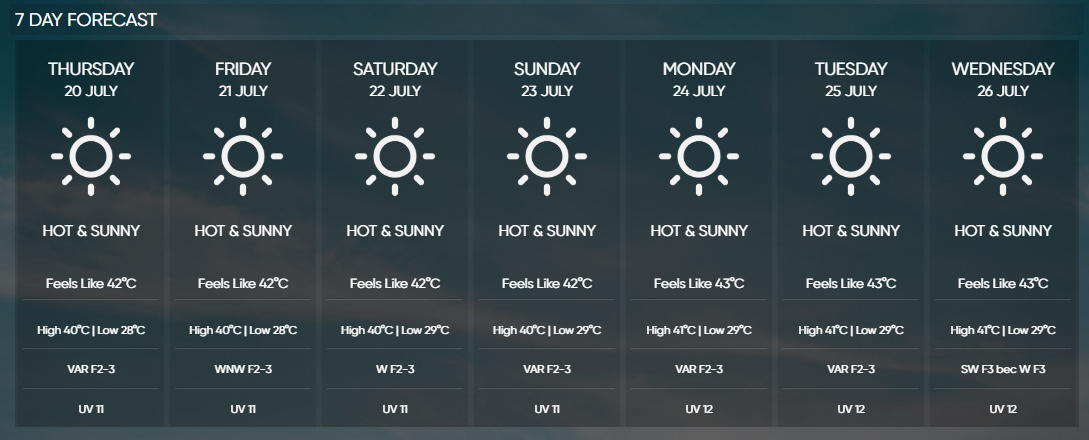The current heatwave is expected to continue until at least Thursday next week, with temperatures forecast to increase from the current 40°C to 41°C as from Monday, according to the Meterological Office.
"Presently, such temperatures are forecast to persist at least until Thursday 27th July 2023," a Met Office spokesperson said adding that forecasts are made for seven days.
If the heatwave, which started on July 16, continues beyond Thursday, it would become the longest heatwave recorded during the summer months in a decade. The longest so far was 12 days long from June 20 until July 1, 2021.
So far, however, based on the current forecast for the upcoming week, the Met Office does not expect that the record maximum temperature will be reached. The hottest July temperature on record is 42.7°C, recorded in 1988.
The heatwave is expected to last all week and intensify next week. Temperatures must be higher than average by five degrees for three or more days in a row to classify as a heat wave. The mean temperature for July is 31.7°C, based on data from 1991 to 2020, the Met Office said.
Why does it 'feel like' it is hotter?
This week, temperatures are forecast to hit 40°C on Friday, Saturday and Sunday (but feel like 42°C) and rise to 41°C on Monday, Tuesday and Wednesday (yet feel like 43°C).
 The Met Office forecast for the next seven days
The Met Office forecast for the next seven daysMany ask why the Met Office differentiates between the actual temperature and how it "feels like".
"Maximum temperatures are measured in the shade using a Stevenson screen. However, in direct sunlight and factoring in a combination of wind speed, direction and humidity, the air temperature will feel different to the human body. For instance, in summer, higher humidity levels are reflected in a 'feels like' temperature value that is higher than the actual temperature," the Met Office explained.
What is causing this heat?
The persistent area of high pressure over the central Mediterranean, extending up from the Sahara Desert to most European countries, is the main contributor to these high temperatures.
Climatologists are also warning about climate change due to greenhouse gases in the atmosphere and the continuous heating of the oceans due to the El Niño effect, the Met Office said.
(El Niño refers to a warming of the ocean surface, or above-average sea surface temperatures, in the central and eastern tropical Pacific Ocean.)
 UV levels are set to rise from 11 to 12 on Monday. Photo: Chris Sant Fournier
UV levels are set to rise from 11 to 12 on Monday. Photo: Chris Sant FournierTemperatures across the globe reached new highs on Monday as heatwaves scorched the northern hemisphere, triggering health warnings and fanning wildfires in the latest stark reminder of the effects of global warming.
Europe, the globe's fastest-warming continent, is reportedly bracing for its hottest-ever temperature this week on Italy's islands of Sicily and Sardinia, where a high of 48°C is predicted.
Soaring UV levels
As temperatures soar, the UV levels are set to increase to 12 on Monday. According to the World Health Organisation, UV levels of 11 and over are regarded as "extremely high" and require extra protection.
On Tuesday the Met Office issued a red weather warning as temperatures are expected to hit 40°C on several days this week, with "extremely high" UV levels.
 Health authorities have urged people to stay hydrated. Photo: Chris Sant Fournier
Health authorities have urged people to stay hydrated. Photo: Chris Sant FournierCharmain Gauci, Director of Public Health, said it is important for everyone to stay hydrated with, take regular intake of water and avoid energy drinks, caffeine, and limit alcohol. She urged people to keep hydrated, avoid heat exhaustion and care for the vulnerable.
People should stay out of the sun between 11am and 4pm and keep out of direct sunlight where possible. Young children and pets should not be left alone in cars, and loose-fitting clothing and hats are advised.